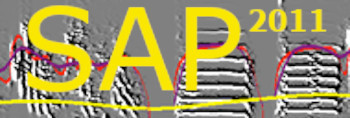Animals table: handling animals' information
| < PREVIOUS: Intro to Spectral Analysis | > NEXT: Spectral Derivatives |
|
|
|
|
How SAP2011 handles Animal Information
Until now we looked at derivatives and features without identifying the animals that the data belong to. Once you insert animal information into SAP2011, such as animal name, date of birth, training method, etc, this information is automatically retrieved each time you access data from that animal. This automatic retrieval has different implementations in different modules, but the example below will clarify the principle and the advantages of this mechanism. Overall, we recommend that each animal you analyze be identified, as shown below.
Let us start by looking at some song development data of a bird called R109. When SAP2011 recorded this bird, the user already inserted the name of the bird, but your new SAP2011 does not have this information. To insert a new bird using the Explore & Score module, click the “New/Change bird” button. You will see an “animals” window that allows you to either select an animal or to insert a new animal. Click the “New Animal” tab and fill in the fields as shown below: From now and on, each time you record from this bird, and each time you open a wave file of this bird, and each time you access any kind of data derived from this bird (e.g., syllable table), SAP2 will use the information you just inserted to make more information available to you.
For example, each time you record from this bird, SAP2011 will generate wave files that start with the bird’s name, e.g.,: R109_39152.86207609_3_11_23_56_47.wav We will describe the SAP2011 files and table names annotation method in the next chapter. Each time you open one of those files, SAP2011 will recognize the file as belonging to bird R109, and based on the file attributes that indicate when the data were generated, and based on the hatching date information, will present to you the age of the bird at the time of recording this file. Let’s try it: Click “Open Sound” and open the sound The age 66 indicate that this bird was 66 days old when these data were recorded. Once you have several birds in the SAP2011 database it is easy to look at one, or a few of them, according to any search and filter criteria. We will start by uploading my CCNY animals database.
The first page, Animals, present a list of animals we experimented with. Use the mouse to click on different records, and scroll up and down, note that the data entry fields below are updated accordingly.
If you like to change a bird entry, or to add a new bird (perhaps based on some of those values already entered for another bird) click “Allow Add/Update”. The table and fields now turned yellow, which indicates that you can now edit the data fields. If you change any field other than the “Name”, and then click Add/Update Record, the information about the bird will be updated according to your changes. If you changed the “Name” field and then click Add/Update Record, SAP2011 will add a new bird at the end of the table. |
|
